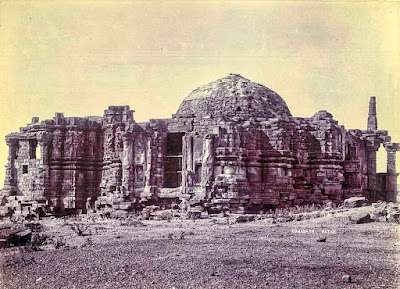Mahmud of Ghazni or Mahmud Ghaznavi was the founder of the Turkic Ghaznavid dynasty, ruling from 998 to 1030. At the time of his death, his kingdom had been transformed into an extensive military empire, which extended from northwestern Iran proper to the Punjab in the Indian subcontinent, Khwarazm in Transoxiana, and Makran.
 |
| Mahmud of Ghazni (center) receives a robe from Caliph Al-Qadir |
He followed policy of plundering India and to establish his rule where he felt it can be permanently established which is now Pakistan. Highly Persianized, Sultan Mahmud continued the bureaucratic, political, and cultural customs of his predecessors, the Samanids, which established the ground for a Persianate state in northwestern India.
His capital of Ghazni evolved into a significant cultural, commercial, and intellectual center in the Islamic world, almost rivalling the important city of Baghdad. The capital appealed to many prominent figures, such as al-Biruni and Ferdowsi.
In 994 Mahmud joined his father Sabuktigin in the capture of Khorasan from the rebel Fa'iq in aid of the Samanid Emir, Nuh II. During this period, the Samanid Empire became highly unstable, with shifting internal political tides as various factions vied for control, the chief among them being Abu'l-Qasim Simjuri, Fa'iq, Abu Ali, the General Bekhtuzin as well as the neighboring Buyid dynasty and Kara-Khanid Khanate. Fight between Mahmud of Ghazni and Abu 'Ali Simjuri.
In 998, Mahmud then traveled to Balkh and paid homage to Amir Abu'l-Harith Mansur b. Nur II. He then appointed Abu'l-Hasan Isfaraini as his vizier, and then set out west from Ghazni to take the Kandahar region followed by Bost (Lashkar Gah), where he turned it into a militarized city. Ghaznavid fortress of Lashkari Bazar in Lashkargah, ancient Bost, southern Afghanistan. It was founded by Mahmud of Ghazni in 998-1030 CE.
Mahmud initiated the first of numerous invasions of North India. On 28 November 1001, his army fought and defeated the army of Raja Jayapala of the Kabul Shahis at the Battle of Peshawar. In 1002 Mahmud invaded Sistan and dethroned Khalaf ibn Ahmad, ending the Saffarid dynasty. From there he decided to focus on Hindustan to the southeast, particularly the highly fertile lands of the Punjab region.
 |
| Sultan Mahmud and his forces attacking the fortress of Zaranj, Afghanistan in 1003 CE. |
In 1005 Mahmud of Ghazni invaded Bhatia (probably Bhera), and in 1006 he invaded Multan, at which time Anandapala's army attacked him. The following year Mahmud of Ghazni attacked and crushed Sukhapala, ruler of Bathinda (who had become ruler by rebelling against the Shahi kingdom). In 1013, during Mahmud's eighth expedition into eastern Afghanistan and Pakistan, the Shahi kingdom (which was then under Trilochanapala, son of Anandapala) was overthrown.
In 1014 Mahmud led an expedition to Thanesar. The next year he unsuccessfully attacked Kashmir. In 1018 he attacked Mathura and defeated a coalition of rulers there while also killing a ruler called Chandrapala. In 1021 Mahmud supported the Kannauj king against Chandela Ganda, who was defeated. That same year Shahi Trilochanapala was killed at Rahib and his son Bhimapala succeeded him. Lahore (modern Pakistan) was annexed by Mahmud.
Mahmud besieged Gwalior, in 1023, where he was given tribute. Mahmud attacked Somnath in 1025, and its ruler Bhima I fled. The next year, he captured Somnath and marched to Kachch against Bhima I. That same year Mahmud also attacked the Jats of Jud and defeated them. Ruins of the Somnath temple in the 19th century.
The last four years of Mahmud's life were spent contending with the influx of Oghuz and Seljuk Turks from Central Asia and the Buyid dynasty. Initially, after being repulsed by Mahmud, the Seljuks retired to Khwarezm, but Togrül and Çagrı led them to capture Merv and Nishapur (1028–1029). Later, they repeatedly raided and traded territory with his successors across Khorasan and Balkh and even sacked Ghazni in 1037. In 1040, at the Battle of Dandanaqan, they decisively defeated Mahmud's son, Mas'ud I, resulting in Mas'ud abandoning most of his western territories to the Seljuks.



